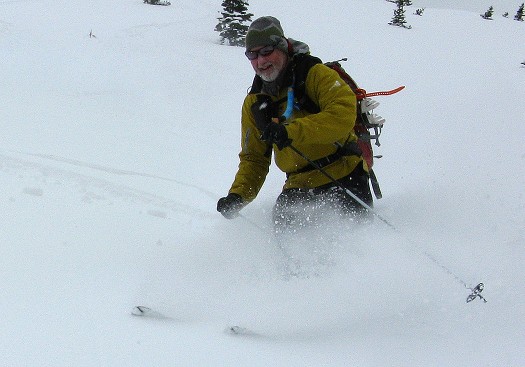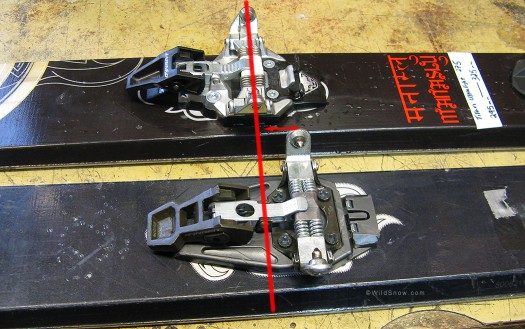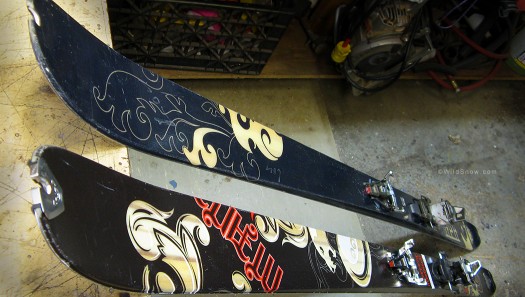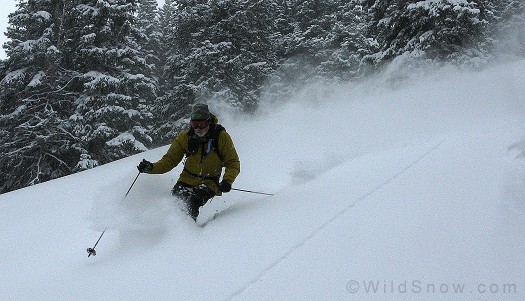Ever seen a yellow lab and a pitbull in a dog fight? No? Neither have I. But when I gave the new 2011/2012 Dynafit Manaslu a good go this weekend, and tried to compare it to the original ‘Slu, I did feel like a gnarly dawg was trying to beat up on the family cuddle puppy. Only unlike the dubious survival of a pacifist in a pitbull attack, being a pacifist in this case still worked.

Dynafit has a dog in this fight. Actually, three (two on the feet and a Lou). Official WildSnow Magazine ski test this weekend involved everything from fresh backcountry powder to hardened suncrust. Reality. Click to enlarge.
April backcountry skiing is about taking what you get. Could be powder as fluffy as chalk flying off Chris Sharma’s hands when he nails his latest monkey hang. Could be hardpan suncrust that shakes your knees like standing on top of the space shuttle during takeoff. Both, perfect for ski testing.
This weekend Lisa and I headed up to the Ragged Mountains (western Colorado) for some April mystery swag, otherwise known as “variable conditions” backcountry skiing. Gracing the bed of the Silverado, a prominently displayed pair of new version Manaslus turned heads on the way out of town. I think I even saw someone snapping photos.
About that yellow labrador. Yes, the original model Manaslu is an ideal plank for human powered powder skiing. Beyond, with freshly sharpened edges the original Manaslu has enough teeth to get you down something steep and icy. But like your detuned family canine, the Manaslu teeth are more suitable for gumming a chew tow (or retrieving a dead duck without shredding it) than getting enough bite to win a battle. More, if your edges are blunt with age, you’d better be feeding those original model Manaslus ground beef rather than steak — hold the bone, please. Add to that the somewhat rearward Manaslu binding mount position, and you got something most of us agree was fun in powder, but less than ideal as a quiver of one for backcountry skiing.
So what kind of breeding made the original Manaslu such a pick of the litter for human powered fluff laps? Two things: Optimal width (95 mm underfoot) for good uphill ergonomics but enough surface area to ski like a modern mid-fat, and a stunning lack of mass (51.5 ounces for a 178 cm plank, new model virtually the same weight, see our weight comparos).
The ski’s width is a result of Dynafit’s ski designers understanding ski alpinism from a European perspective, meaning the arcane and secret knowledge that to enjoy ski touring you don’t need to haul around a pair of living room recliner chairs on your feet. The weight? Easy. Eliminate the mounting reinforcement area by providing screw inserts made of lightweight nylon, build the ski with a partially foam core, and laminate with minimal resin.
All good. But to make doubly sure the original Manaslu was a forgiving ride the binding/boot position was chosen somewhat rearward. Combine that with less running surface in the rear due to turned up tail, and these skis had a noticeable amount of tip out there in front of you. If you wanted a bit more pit bull and a little less cuddle you could use the forward position the inserts allowed. But even the forward position was a bit aft compared to where instinct and experience would tend to place it for backcountry skiing. I’ve experimented extensively with both positions. I like the forward one, but kept going back to the rearward. In truth, the best for me probably would be halfway between the two, and certainly no more forward than the front position.

Dynafit Manaslu binding position. New version at top. Both bindings mounted in rearward position provided by inserts in ski. 1.5 cm difference is significant, noticeable while skiing.
The new Manaslu tries to be more the animal you say “sick” to and less the one you’d use as a foot warmer. Perhaps most effectively and least detrimental to all around performance, Dynafit added what’s said to be a layer of carbon fibers to the build, the idea being more bite on hardpack, and added beef so a farther forward mount position wouldn’t overpower the ski. I tested the new model Manaslu on steep frozen suncrust, and can confidently say it does have more edgehold than the older version. Does it have enough hardpack performance to be the dog that hunts as well as cuddles? Nope, not in my opinion. A ski this light, without damping, is simply not going to ski the firm stuff smoothly at speed. In other words, walk the dog, don’t run it, and you’ll have a good day. But since it’s important let me state again that the new ‘Slu is going to be much less terrifying in situations such as getting down a steep icy mountainside at night, with a battery failed headlamp. Don’t ask me how I know.
Thus, the new Manaslu is still a good machine for everything from breakable crust to powder — perhaps even better if you want a ski that gives a bit more back and is less of a couch you sink into and tweak your back getting out of. But what about that new mount position? Okay, as stated above, compare between same positions and new model is about 1.5 centimeters forward of old. Compensate by moving the old to the forward, and old is still about a centimeter back from as far back as you can mount the new ‘Slu.
Ski the new Manaslu with the new rearward (but still 1.5 centimeters forward from old) mounting position, and you can feel the difference. Much less of a couch ride in the powder, and the tip engages more readily on the hardpack — sometimes a bit too readily. Indeed, I found myself immediately thinking that if these demos were mine, I’d be aggressively detuning the tip edges to prevent hooking — and even doing this to lessen engagement in denser powder and crud. By “aggressively detuning” I mean taking a grinder to the non running surface tip edges and rounding them, as well as stoning out the edge a few centimeters down into the running surface. In the pow, I felt that big easy sweet spot of the older Manaslu was reduced to a region somewhere between the rigid rear cuff of my TLT5s to somewhere about half way to full boot front engagement, while with the old ‘Slu dogs I can completely collapse the boot forward and still see those tips riding high and proud up ahead. Are these negatives or positives? Are there times for agro dogs and times for cuddly human companions?
Yes, the new Manaslu is more of a performance plank. Is it a pit bull? Not quite. More edgehold yields better versatility. Forward mounting position yields a lively yet more demanding feel. Yet for some skiers that forward mount might be a bit much, especially if you’re simply looking for the most forgiving ski possible, with little care about icy descents in the dark or how tight you can make powder turns. What is more, take a skier with smaller feet and associated smaller boot sole length, stick him in even the rearward insert forced mount position on the new model, and you could definitely end up too far forward. Uh huh, the deep dark secret disadvantage of inserts — they forego using a boot center mark lined up with a ski mounting mark, which compensates nicely for different boot lengths.
Just as with the older model, this is most definitely not a hardpack ski. Serviceable, yes. Survivable, yes. But just like that pit bull, the new model’s teeth are sharp and the dog tends to shake its victim without letting go (or, as my obfuscated metaphor is trying to communicate, not a damp ski that makes smooth hardpack turns). Conversely, the old model is a fuzzy yellow labrador that will cuddle on the couch as she always has, but has dull teeth. Can the new model be more a lab and less a bulldog? Sure. Use the rearward mounting position and detune the tip. Also, if skiing longer lengths using insert dictated mount position, you’ll want to have average sized feet so you don’t end up too far forward. (Which begs the question, can the new model be mounted without using the inserts, to tune mount position? Not really, as space between the inserts is minimal, and if you use the rear pair of toe unit inserts for the front pair of binding screws, you end up too far back for any foot size or performance need.)
Conclusion: New model Manaslu is more versatile, but still a quiver ski for backcountry skiing. Would I travel with it? For unknown conditions or springtime ski mountaineering, I’d prefer something that was more a compromise between hard snow and soft. On the other hand, I’d still call this an ideal hound for the human powered powder hunter. So if my destination was a softer snow region or season, sure I’d travel with the new Manaslu. The older model was a cuddly pacifist labrador. The new model has a bit of pit bull DNA mixed in. Both work.
(Note, this is not a rockered ski by our definition, though Dynafit word is that they use a “ski touring specific rockered tip,” which simply means a nice long slow-rise tip. I’ve always felt this type of tip is a terrific way to build a powder ski that has some of the performance advantage of a true rockered ski, while still the quick engagement and liveliness of non-rockered edges. This type of construction still works with the new model Manaslu, though with the forward mount position I found myself wondering if a bit of true rocker just behind the tip would have lengthened the sweet spot.)
Previous Manaslu backcountry skiing review.
WildSnow.com publisher emeritus and founder Lou (Louis Dawson) has a 50+ years career in climbing, backcountry skiing and ski mountaineering. He was the first person in history to ski down all 54 Colorado 14,000-foot peaks, has authored numerous books about about backcountry skiing, and has skied from the summit of Denali in Alaska, North America’s highest mountain.


